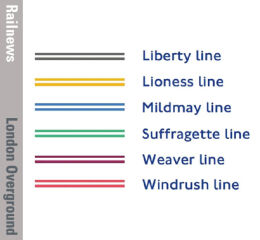Posted 15th February 2024 | 1 Comment
New look for London Overground as routes gain colours

The routes which make up London Overground are being given distinctive names and colours on the Underground map for the first time.
The system was launched by Mayor Ken Livingstone in 2007 when Transport for London took control of Silverlink Metro, which had shabby trains and infrastructure after many years of under-investment which went back to the days of British Rail. Indeed, in 1963 Dr Beeching had recommended the closure of the line from Richmond across north London which then served the former terminus of Broad Street and now runs to Stratford.
Sixty years later this line is unrecognisable, with frequent, modern trains calling at refurbished stations. Other parts of the Overground are similar.
It was originally given the colour brown, but by the time the launch took place in 2007 the colour had become orange.
TfL says its research had revealed that some passengers find the London Overground network confusing and that they would find it easier to navigate if the routes could be distinguished.
Each route will be represented by a new line name and colour on the Underground map, at stations and on digital journey planning apps, such as TfL Go.
TfL had worked with passengers, stakeholders, historians, industry experts and local communities to decide names representing the areas served and also marking London's history and cultural diversity.
The six routes will be the Lioness line from Euston to Watford Junction via Wembley Central, to recognise the achievements of the England women's football team. On the map it will be marked with yellow parallel lines.
The Mildmay line will run between Stratford and Richmond or Clapham Junction. It has been named after the small charitable hospital in Shoreditch, which played an important role during the HIV/Aids crisis in the 1980s. It will be marked with blue parallel lines.
The Windrush line from Highbury & Islington to Clapham Junction or New Cross, Crystal Palace or West Croydon serves several areas with strong ties to Caribbean communities. It will be marked with red parallel lines.
The Weaver line will be from Liverpool Street to Cheshunt, Enfield Town or Chingford. Some of its stations serve areas of London known for their importance in the textile trade. It will be marked with maroon parallel lines.
The Suffragette line will run between Gospel Oak and Barking Riverside, and its name celebrates how London's East End working-class community fought for women to have the right to vote. It will be marked with green parallel lines.
Finally, the Liberty line will be the detached stretch between Romford and Upminster. Its name refers to the freedom that is a ‘defining feature of London’ and also refers to the historical independence of the people of Havering, through which it runs. The manor of Havering was given a royal charter in 1465 by Edward IV, which conferred privileges on its people. This line will be shown as grey parallel lines.
The Mayor Sadiq Khan said: ‘Giving each of the Overground lines distinct colours and identities will make it simpler and easier for passengers to get around. In re-imagining London’s tube map, we are also honouring and celebrating different parts of London’s unique local history and culture.
Transport commissioner Andy Lord added: ‘The London Overground is one of the most successful railways in the country and has grown to carry more than three million customers a week. The network, which has grown quite considerably since 2007, is currently shown as a complicated network of orange on route maps. This can be confusing for customers less familiar with the network and could be a barrier for some wanting to use the Overground. These new names and line colours will simplify the maps and routes for our customers, and it is hoped it will encourage more people to make the most of our services. It is also a great way to tell the stories of some important parts of London’s cultural diversity.’
Reader Comments:
Views expressed in submitted comments are that of the author, and not necessarily shared by Railnews.

Philip Russell , Carlisle
Hard to tell if this scheme will stand the test of time or end up like the Network South East route branding’s of the early 1990s